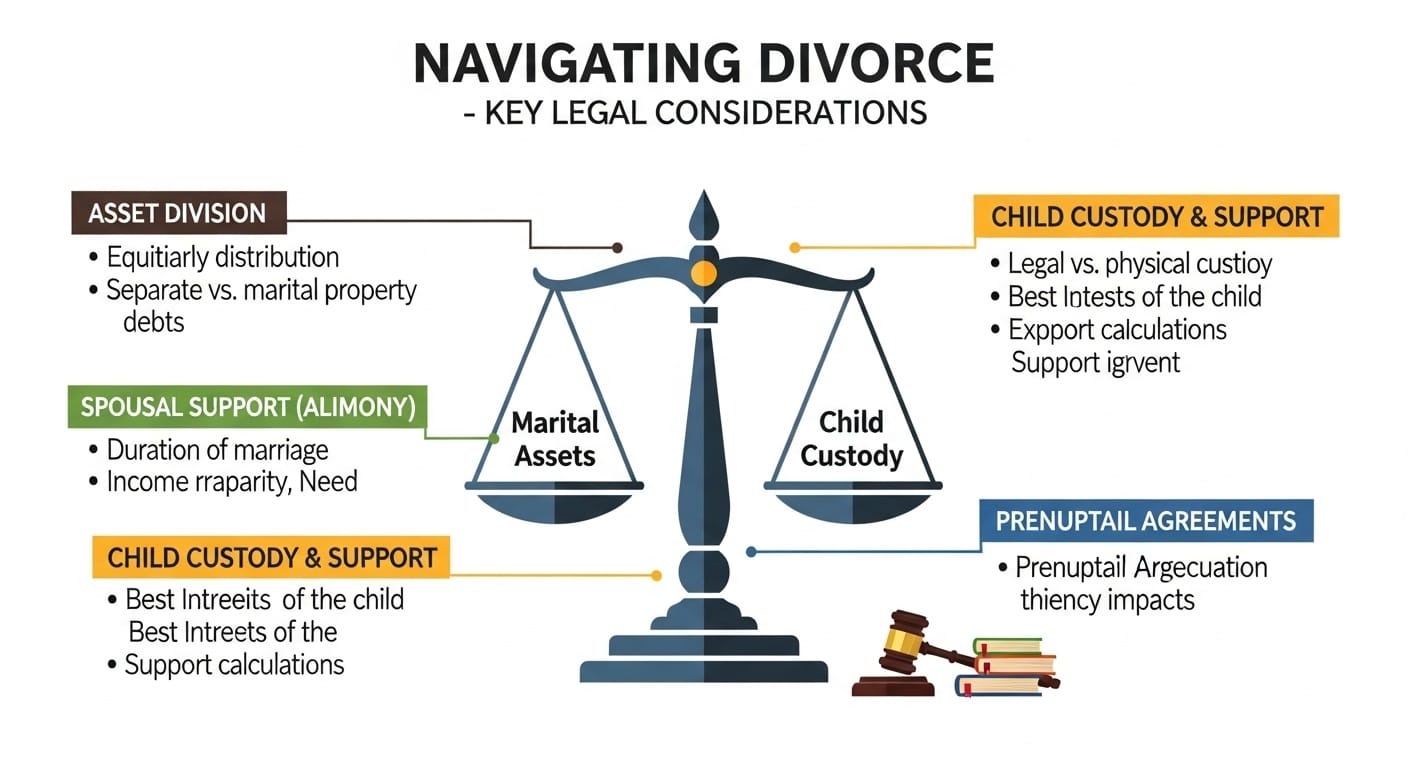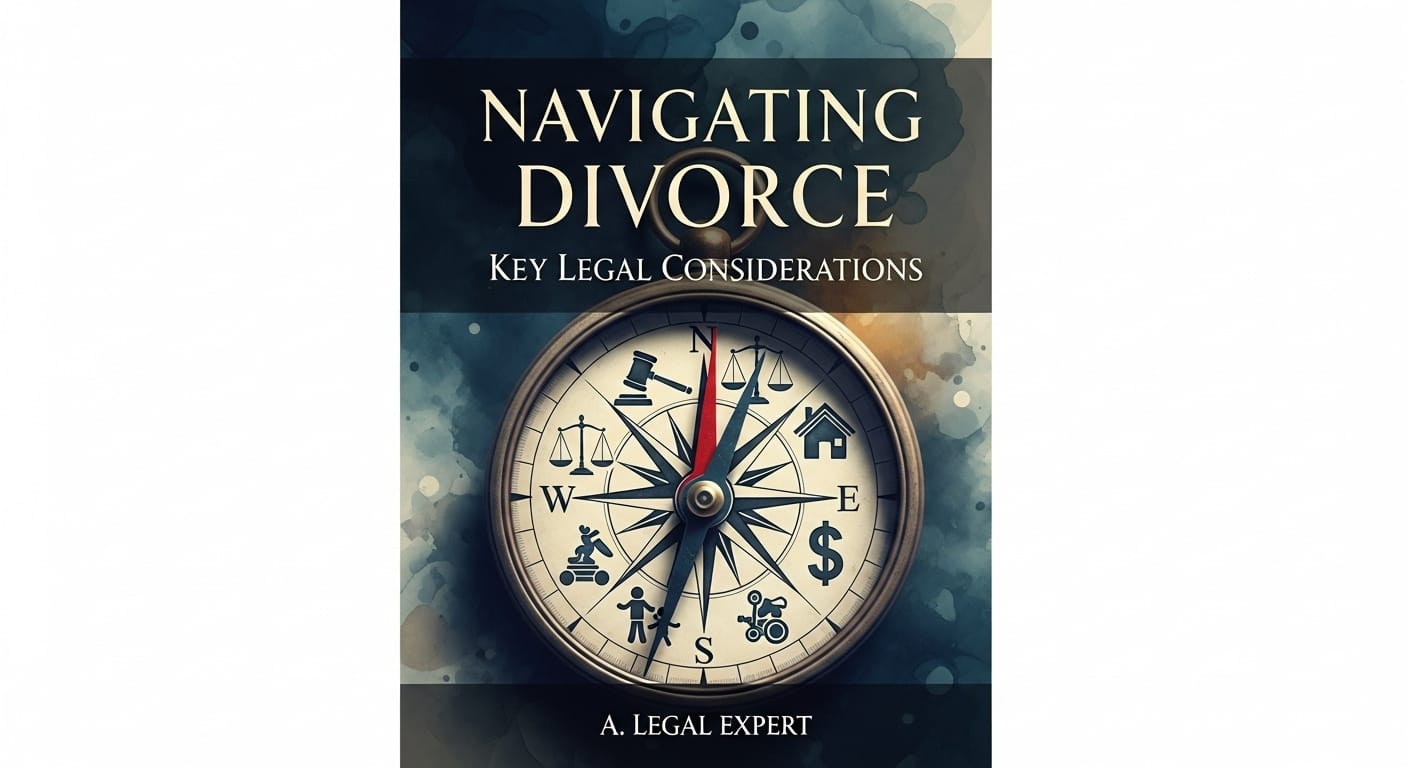Please Note: This post may contain affiliate links. If you click one of them, we may receive a commission at no extra cost to you. As an Amazon Associate, I earn from qualifying purchases.
Divorce is a word that tends to send shivers down spines—or maybe just inspire a sigh and a trip to the freezer for some ice cream. Whether you’re initiating or receiving those dreaded papers, navigating a divorce is about as fun as untangling Christmas lights in July.
The good news is that you don’t have to go it alone. With a little preparation, a smidge of legal know-how, and maybe a healthy dose of humor, you can make it through this challenging chapter relatively unscathed. Let’s dive into some of the key legal considerations, and maybe you’ll come out of this with your sanity—and your finances—still intact.

Top Takeaways and Key Concepts
Understand Divorce Grounds: Decide between fault-based or no-fault divorce based on goals and circumstances.
Divide Assets Fairly: Know your state’s rules—community property or equitable distribution—and include debts.
Plan Custody Arrangements: Focus on the child’s best interests when determining legal and physical custody.
Calculate Spousal Support: Consider marriage length, earning potential, and sacrifices when determining alimony.
Explore Mediation and Arbitration: Use alternatives to litigation to save time, reduce costs, and ease conflict.
Summary of This Article
The article outlines key legal considerations during a divorce, including choosing between fault-based or no-fault grounds, dividing assets and debts according to state rules, and planning custody arrangements with the child’s best interests in mind. It explains spousal support calculations based on earning potential and marriage duration, and emphasizes exploring mediation or arbitration to minimize costs and conflict. Finally, it advises preparing for the post-divorce future by updating financial, estate, and insurance plans, ensuring a smoother transition into the next chapter of life.
Understanding the Grounds for Divorce

First things first: the “why.” Every divorce has a story, though some might be more colorful than others. Legally, the grounds for divorce vary depending on where you live, but they typically fall into two categories: fault-based and no-fault.
No-fault divorce is like the “we grew apart” option. It usually doesn’t require anyone to admit wrongdoing, which is great if you’d rather not air the dirty laundry in court. On the other hand, fault-based divorce lets you point fingers. Adultery? Abandonment? Financial recklessness? These might give you leverage, but they can also drag out the process.
To be fair, deciding whether to go fault-based or no-fault often depends on your goals. If you’re aiming for an amicable split, no-fault is usually smoother. But if there’s a significant power imbalance—or you’ve got a list of grievances that could rival War and Peace—a fault-based approach might make sense.
Dividing Assets and Property

Let’s talk about the stuff—because, as it turns out, dividing your worldly possessions is not as simple as a 50-50 split. Property division can get messy, especially if emotions are running high or if the assets include things like a shared business, retirement accounts, or Grandma’s priceless antique vase.
Interestingly enough, the way assets are divided depends on whether your state follows community property rules or equitable distribution. In community property states, marital assets are split right down the middle. Equitable distribution, on the other hand, focuses on what’s fair—which might not always mean equal.
By the way, “fair” is one of those words that seems to mean different things to different people, so having a solid lawyer in your corner can make all the difference. And don’t forget: debts are assets’ annoying little siblings. Yep, those get divided too.
Addressing Custody and Parenting Plans
If there are kids in the mix, custody is going to be a big-ticket item on your divorce agenda. And no, the judge isn’t going to just hand the kids to the parent with the bigger Netflix account.
Legal custody determines who gets to make major decisions, like where the kids go to school or whether they should eat broccoli. Physical custody, meanwhile, decides where the kids actually live. Joint custody arrangements are increasingly popular, but sole custody may still be an option in certain cases.
Then again, custody battles can get emotional fast. Courts prioritize the best interests of the child, so be prepared to show that you’re stable, supportive, and maybe just a smidge better at parenting than your soon-to-be ex.
Calculating Spousal Support
Ah, spousal support—otherwise known as alimony. This is where the phrase “to have and to hold” starts sounding a lot like “to pay and to pay some more.” The goal of alimony is to ensure that one spouse isn’t left high and dry, especially if they sacrificed their career or income potential during the marriage.
The amount and duration of support depend on a variety of factors, including the length of the marriage, each spouse’s earning potential, and who’s more likely to invest in a lucrative side hustle.
On the other hand, not all divorces involve alimony. If both spouses are financially independent—or if the marriage was shorter than a celebrity engagement—it might not even come up.
Navigating Legal Fees
Divorce lawyers don’t come cheap, but let’s be real: this isn’t the time to skimp. Hiring a qualified attorney is an investment in your future, especially if the split involves complex assets or custody disputes.
Speaking of which, there are ways to keep costs manageable. Mediation, for example, is often less expensive than going to trial. And if both parties are willing to negotiate, you might even be able to avoid a courtroom showdown altogether.
Considering Mediation and Arbitration
Mediation and arbitration are like the middle ground between an amicable handshake and a full-blown legal battle. Mediation involves a neutral third party who helps you and your ex reach an agreement, while arbitration gives that third party decision-making power.
To be fair, both options can save time and money, but they’re not always a good fit—especially if there’s a significant power imbalance or unresolved anger. Still, if you’re willing to play nice (or at least pretend to), these alternatives can make the process a whole lot smoother.
Preparing for the Future
Divorce might feel like the end of the world, but it’s really just the beginning of a new chapter. Once the papers are signed and the dust settles, take some time to reassess your financial and emotional goals.
By the way, updating your estate plan and insurance policies is a must. The last thing you want is for your ex to still be listed as your life insurance beneficiary five years down the road.
Resources
American Bar Association – Divorce and Custody Resources
https://www.americanbar.org/groups/public_education/resources/
Legal Aid Society – Family Law Support
https://www.legalaid.org/
National Center for Family Law
https://www.nationalfamilylaw.org/
Frequently Asked Questions
What are the main types of divorce?
Divorces are typically classified as fault-based or no-fault. A no-fault divorce requires no proof of wrongdoing, while a fault-based divorce involves specific allegations such as adultery or abandonment.
How are assets divided during a divorce?
Asset division depends on state law. Community property states split marital assets equally, while equitable distribution states divide them fairly based on each spouse’s financial situation and contributions.
What factors affect child custody decisions?
Courts prioritize the child’s best interests by evaluating stability, caregiving ability, and the child’s relationship with each parent when determining custody and parenting arrangements.
How is spousal support calculated?
Spousal support, or alimony, is determined by factors such as marriage length, each spouse’s earning capacity, financial needs, and any sacrifices made during the marriage for family or career reasons.
Can mediation or arbitration replace a traditional divorce trial?
Yes, mediation and arbitration are effective alternatives that allow couples to resolve disputes privately with the help of a neutral third party, often saving time, stress, and legal costs.
How can I manage legal fees during a divorce?
To manage costs, consider mediation, negotiate settlements where possible, and choose an attorney experienced in family law who can help you focus resources efficiently.
What steps should I take after my divorce is finalized?
After divorce, update your financial accounts, estate plans, and insurance beneficiaries to reflect your new circumstances and protect your future interests.

Kevin Collier is a legal expert passionate about simplifying complex legal concepts for everyday individuals. With a focus on providing clear, practical information, he covers a wide range of topics, including rights, responsibilities, and legal procedures. Kevin aims to empower readers with the knowledge they need to navigate the legal landscape confidently, ensuring they can make informed decisions regarding their legal matters. Through insightful articles and easy-to-understand resources, he helps demystify the law, making it accessible to all.










